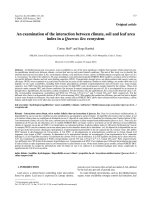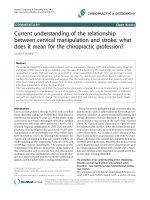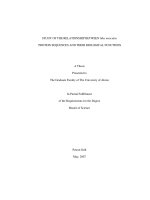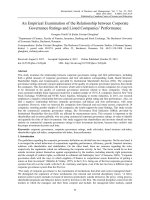An Exploratory Study of the Relationship Between Lean Production and Corporate Social Responsibility in Vietnamese SMEs
Bạn đang xem bản rút gọn của tài liệu. Xem và tải ngay bản đầy đủ của tài liệu tại đây (313.07 KB, 11 trang )
Header Page 1 of 14.
VNU Journal of Science: Economics and Business Vol. 30, No. 2 (2014) 28-38
An Exploratory Study of the Relationship Between
Lean Production and Corporate Social Responsibility
in Vietnamese SMEs
Hoàng Văn Hải*, Nguyễn Phương Mai
VNU University of Economics and Business,
., Hanoi, Vietnam
Received 23 May 2014
Revised 28 June 2014; Accepted 11 July 2014
Abstract: In recent decades, along with a deeper integration into the world economy, when
Vietnamese enterprises have had to respect and comply with international competitive laws, the
issue of corporate social responsibility (CSR) has drawn a lot of attention and become an essential
requirement for enterprises today. However, many Vietnamese small and medium sized enterprises
(SMEs) are still wandering around trying to find ways to implement CSR while at the same time
they have to face a number of challenges such as low productivity, out-of-date technology, and
limited financial and human resources. This paper presents the concept of lean manufacturing in
CSR, and points out the arguments showing that lean manufacturing can be a solution to effective
and sustainable CSR implementation. An empirical research model will also be suggested to study
the relationship between lean manufacturing and CSR in the context of Vietnamese SMEs.
Keywords: Lean management, corporate social responsibility, SMEs, Vietnam.
1. Introduction *
put significant pressures on them in finding
ways to do business in a more sustainable and
socially responsible manner. In such a context,
implementing corporate social responsibility
(CSR) can be an important step on the way
towards fostering sustainable business for
Vietnamese enterprises. According to some
previous studies on CSR in Vietnam, SMEs still
have an ambiguous awareness of CSR. Thus,
CSR implementation is merely a reactive
response to the requirements of foreign
business partners. CSR activities in these SMEs
are unsustainable. Many SMEs are still
wandering around trying to find the solution to
the lack of financial resources to support their
CSR activities such as donations, etc.
Since Vietnam joined the World Trade
Organization (WTO) in 2006, the country has
been more open to the world economy. As a
result, many foreign companies have come to
do business in Vietnam while the domestic
companies, who mainly are small and medium
sized enterprises (SMEs), have become more
involved in the global value chain by supplying
raw materials and manufacturing parts, or by
being contractors for multinational companies.
Therefore, domestic enterprises have to operate
in a more fiercely competitive market, which
_______
*
Corresponding author. Tel.: 84-983288119
E-mail:
28
Footer Page 1 of 14.
Header Page 2 of 14.
H.V. Hải, N.P. Mai / VNU Journal of Science: Economics and Business Vol. 30, No. 2 (2014) 28-38
In the current context of Vietnamese SMEs,
in order to implement CSR, it is necessary to
find a method which is not costly but still can
ensure the sustainability of CSR activities. Lean
production can be considered as such a method
to help SMEs deal with the problem mentioned.
To clarify the argument that lean production is a
way to implement CSR sustainably, it is a must
to explore the essence of lean production
model, the concept of CSR and the relationship
between them.
2. Theoretical background of lean
production
and
corporate
social
responsibility (CSR)
2.1. Lean production
The concept of “lean manufacturing” or
“lean production” was first introduced in 1990
in the book “The machine that changed the
world” of Daniel Jones, James Womack and
Daniel Roos. The authors defined “lean
production” as the set of "tools" that assist in
the identification and steady elimination of
waste to reduce production time, and increase
productivity and profit. In the lean production
system, to increase production efficiency,
companies focus on identifying wastes
including tangible and intangible ones, then use
scientific tools and methods to minimize nonvalue added activities in the production process
[1]. According to Ohno and Taiichi (1988),
there are 7 types of lean waste, including overproduction, inventory, defects, over-processing,
motion, transport and handling, and waiting [2].
Later an eighth waste was defined by
Womack et al. (2003); it was described as
manufacturing goods or services that do not
meet customer demand or specifications. Many
others have added the "waste of unused human
talent" to the original seven wastes [3]. Another
Footer Page 2 of 14.
29
waste of an ineffective information system was
also identified [4]. To sum up, the list of lean
wastes includes not only tangible but also
intangible ones, and it is believed that
eliminating the intangible wastes is much more
complex than the tangible ones, as companies
may not recognize the existence of such wastes.
Currently, the three most popular tools of
waste elimination are 5S, Kaizen (continuous
improvement)
and
Mieraku
(visual
management). Beside these tools, there are
several other tools in lean production such as
Standard Work, Value Stream Mapping,
Preventative Maintenance, Total Productive
Maintenance, Changeover/setup Time, Kanban,
Pacemaker, Overall Equipment Effectiveness,
and etc [5].
The application of the tools mentioned
helps a company to achieve its goal of cost
reduction. Some companies that have applied
lean production have reported results such as:
average production site per machine reduced by
45 percent, wastes reduced up to 90 percent,
production cycle reduced from 16 weeks to
about 5 or 6 days, delivery time is shortened
from 4-20 weeks to 1-4 weeks [6, 7].
In fact, applying lean production helps
companies to effectively utilize available
resources to improve product quality, and to
shorten production time to meet the customers’
demand [6, 8]. Moreover, lean production also
promotes an innovation culture, enhances the
professionalism in the working environment for
employees,
and
increases
customer’s
satisfaction and brand loyalty [9].
2.2. Corporate social responsibility
The CSR concept appeared for the first time
in 1953 in the book “Social Responsibilities of
the Businessmen” of Howard Rothmann
Bowen. Bowen (1953) defined CSR as “an
obligation to pursue policies to make decisions
Header Page 3 of 14.
H.V. Hải, N.P. Mai / VNU Journal of Science: Economics and Business Vol. 30, No. 2 (2014) 28-38
30
and to follow lines of action which are
compatible with the objectives and values of the
society” [10]. Since that early approach, the
term of CSR has been elaborated a great deal.
CSR is also considered as “the continuing
commitment of business to contribution to
sustainable economic development, working
with employees, their families, the local
community and society at large to improve their
quality of life, in ways that are both good for
business and good for development” [11].
Recently, the CSR concept was updated by
the European Commission in 2011 as “a
process whereby companies integrate social,
environmental and ethical issues into their
business operations and strategy in close
interaction with their stakeholders, going
beyond the requirements of applicable
legislation and collective agreements”. This
new concept shows that “a strategic approach to
CSR is increasingly important to the
competitiveness of enterprises, helping them to
create value both for
owners and
shareholders… to win the trust and respect of
citizens” [12].
CSR is a complex and ambiguous concept
with no single conceptualization. However, the
main topics of CSR as defined in ISO26000
include the following.
R
Figure 1: CSR issues in ISO26000.
Source: International Standard Organization, 2010, .
Within manufacturing, the ISM1 has
developed principles of social responsibility for
_______
1
ISM, the short name of Institute of Supply Management
- the first supply chain management organization in the
world, established in 1915. Through training activities,
research projects and technology transfer, ISM has
developed its strong impact on individuals and
organizations worldwide.
Footer Page 3 of 14.
������������������������������������������������������������������������������������������������������������������������������������������������������������������������������������������������������������������������������������������������������������������������������������������������������������������������������������������������������������������������������������������������������������������������������������������������������������������������������������������������������������������������������������������������������������������������������������������������������������������������������������������������������������������������������������������������������������������������������������������������������������������������������������������������������������������������������������������������������������������������������������������������������������������������������������������������������������������������������������������������������������������������������������������������������������������������������������������������������������������������������������������������������������������������������������������������������������������������������������������������������������������������������������������������������������������������������������������������������������������������������������������������������������������������������������������������������������������������������������������������������������������������������������������������������������������������������������������������������������������������������������������������������������������������������������������������������������������������������������������������������������������������������������������������������������������������������������������������������������������������������������������������������������������������������������������������������������������������������������������������������������������������������������������������������������������������������������������������������������������������������������������������������������������������������������������������������������������������������������������������������������������������������������������������������������������������������������������������������������������������������������������������������������������������������������������������������������������������������������������������������������������������������������������������������������������������������������������������������������������������������������������������������������������������������������������������������������������������������������������������������������������������������������������������������������������������������������������������������������������������������������������������������������������������������������������������������������������������������������������������������������������������������������������������������������������������������������������������������������������������������������������������������������������������������������������������������������������������������������������������������������������������������������������������������������������������������������������������������������������������������������������������������������������������������������������������������������������������������������������������������������������������������������������������������������������������������������������������������������������������������������������������������������������������������������������������������������������������������������������������������������������������������������������������������������������������������������������������������������������������������������������������������������������������������������������������������������������������������������������������������������������������������������������������������������������������������������������������������������������������������������������������������������������������������������������������������������������������������������������������������������������������������������������������������������������������������������������������������������������������������������������������������������������������������������������������������������������������������������������������������������������������������������������������������������������������������������������������������������������������������������������������������������������������������������������������������������������������������������������������������������������������������������������������������������������������������������������������������������������������������������������������������������������������������������������������������������������������������������������������������������������������������������������������������������������������������������������������������������������������������������������������������������������������������������������������������������������������������������������������������������������������������������������������������������������������������������������������������������������������������������������������������������������������������������������������������������������������������������������������������������������������������������������������������������������������������������������������������������������������������������������������������������������������������������������������������������������������������������������������������������������������������������������������������������������������������������������������������������������������������������������������������������������������������������������������������������������������������������������������������������������������������������������������������������������������������������������������������������������������������������������������������������������������������������������������������������������������������������������������������������������������������������������������������������������������������������������������������������������������������������������������������������������������������������������������������������������������������������������������������������������������������������������������������������������������������������������������������������������������������������������������������������������������������������������������������������������������������������������������������������������������������������������������������������������������������������������������������������������������������������������������������������������������������������������������������������������������������������������������������������������������������������������������������������������������������������������������������������������������������������������������������������������������������������������������������������������������������������������������������������������������������������������������������������������������������������������������������������������������������������������������������������������������������������������������������������������������������������������������������������������������������������������������������������������������������������������������������������������������������������������������������������������������������������������������������������������������������������������������������������������������������������������������������������������������������������������������������������������������������������������������������������������������������������������������������������������������������������������������������������������������������������������������������������������������������������������������������������������������������������������������������������������������������������������������������������������������������������������������������������������������������������������������������������������������������������������������������������������������������������������������������������������������������������������������������������������������������������������������������������������������������������������������������������������������������������������������������������������������������������������������������������������������������������������������������������������������������������������������������������������������������������������������������������������������������������������������������������������������������������������������������������������������������������������������������������������������������������������������������������������������������������������������������������������������������������������������������������������������������������������������������������������������������������������������������������������������������������������������������������������������������������������������������������������������������������������������������������������������������������������������������������������������������������������������������������������������������������������������������������������������������������������������������������������������������������������������������������������������������������������������������������������������������������������������������������������������������������������������������������������������������������������������������������������������������������������������������������������������������������������������������������������������������������������������������������������������������������������������������������������������������������������������������������������������������������������������������������������������������������������������������������������������������������������������������������������������������������������������������������������������������������������������������������������������������������������������������������������������������������������������������������������������������������������������������������������������������������������������������������������������������������������������������������������������������������������������������������������������������������������������������������������������������������������������������������������������������������������������������������������������������������������������������������������������������������������������������������������������������������������������������������������������������������������������������������������������������������������������������������������������������������������������������������������������������������������������������������������������������������������������������������������������������������������������������������������������������������������������������������������������������������������������������������������������������������������������������������������������������������������������������������������������������������������������������������������������������������������������������������������������������������������������������������������������������������������������������������������������������������������������������������������������������������������������������������������������������������������������������������������������������������������������������������������������������������������������������������������������������������������������������������������������������������������������������������������������������������������������������������������������������������������������������������������������������������������������������������������������������������������������������������������������������������������������������������������������������������������������������������������������������������������������������������������������������������������������������������������������������������������������������������������������������������������������������������������������������������������������������������������������������������������������������������������������������������������������������������������������������������������������������������������������������������������������������������������������������������������������������������������������������������������������ in Vietnamese SMEs?
(2) Which types of wastes will be
eliminated when lean production is applied in
Vietnamese SMEs?
(3) Does lean waste elimination lead to
CSR benefits in Vietnamese SMEs? What are
the specific benefits?
4. Research methodology
To find the answer to the research
questions, in this study, we use a qualitative
method to explore the potential relationship
between lean production and CSR. Therefore,
we conduct a series of in-depth-interviews with
10 experts in operation management and CSR,
and with 30 managers in Vietnamese SMEs
from the enterprises that have partially
implemented lean production. Experts are from
NGOs, associations and universities such as
Vietnam Productivity Center (VPC), Vietnam
Leather and Footwear Association (LEFASO),
Vietnam Textile and Apparel Association
(VITAS), Ministry of Labor-Invalids and Social
Affairs
(MOLISA),
Vietnam
General
Confederation of Labor, Vietnam Chamber of
G
Footer Page 7 of 14.
Commerce and Industry (VCCI), United Nation
Industrial
Development
Organization
(UNIDO), Vietnam Cleaner Production Center
(VNCPC), Japan International Corporation
Agency (JICA), VNU University of Economics
and Business, and Hanoi University of Sciences
and Technology. Managers that participated in
our interviews are from SMEs of 5 sectors:
textile, leather and shoes, electronics, seafood
processing, and machinery. We choose these 5
sectors to study because they are exporting
industries that are under increasing pressure to
implement CSR currently. Moreover, the
interviewed SMEs have applied lean production
to a certain extent.
5. Findings and discussion
After analyzing the information from the
in-depth-interviews, some initial findings
from our qualitative study are presented as
the following:
Firstly, it is interesting to find that the three
most popular lean production tools that have
been applied in Vietnamese SMEs are 5S,
Kaizen and visual management. A hundred
percent of the interviewed SME managers
confirmed that their companies have applied
these three tools for a couple of years.
Secondly, regarding the effectiveness of
waste elimination by applying lean production
tools such as 5S, Kaizen, visual management,
over 90 percent of experts believe that lean
waste will surely be eliminated when these
tools are applied. Whereas about 80 percent of
the managers confirmed that they have applied
some lean production tools, mostly 5S and
Kaizen, and as a result almost all lean waste
was minimized (Figure 2).
Header Page 8 of 14.
H.V. Hải, N.P. Mai / VNU Journal of Science: Economics and Business Vol. 30, No. 2 (2014) 28-38
35
100%
50%
0%
Over-
Inventory
Defects
Over-
Motion
Handling
Waiting
Work
IS
Experts
93,50%
90,30%
89,40%
80,60%
86,10%
87,40%
80,90%
75,80%
83,40%
Managers
91,60%
95,20%
92,70%
75,30%
83,90%
80,00%
76,50%
60,50%
76,30%
Lean waste
Figure
Figure 2: Lean waste elimination when applying lean production tools.
Source: Authors’ analysis from in-depth interviews.
Figure 2 shows that experts and managers
seem to have similar viewpoints of the types of
waste that can be eliminated when companies
apply lean production. For the two new lean
types of waste namely waste caused by working
methods or improper thinking and waste caused
by inefficient information system, the
interviewed managers are a little doubtful
whether it is possible to eliminate these wastes
by using lean production tools. The simple
reason for their doubt is that in most
Vietnamese SMEs, the information system is
under-developed and production technology is
low. Consequently, it is difficult to recognize
whether this type of waste is really cut off or
not. Furthermore, the waste caused by improper
working methods or thinking is very hard to be
observed as it is intangible, while most
Vietnamese SMEs are managed on the basis of
family rules so that managers find it complex to
evaluate this waste.
Thirdly, the relationship between waste
elimination and CSR benefits is confirmed by
both group of experts and group of managers.
They reach the common agreement that when
wastes are minimized, some positive results are
brought about, particularly the benefits in terms
of environmental protection and working
conditions for employees. Based on the
viewpoints of experts and managers when we
interviewd, we summarize the eight CSR
benefits in Table 1.
Table 1: CSR benefits from waste elimination
No.
1
2
3
4
5
6
7
8
CSR benefits
Reduction of accidents at workplace
Reduction of demand for lighting
Reduction of demand for energy used for air conditioning
and fans…
Reduction of over-using chemicals in production
Reduction of solid waste, waste water and air emission
Reduction of resources used in production process
Reduction of possibility to be affected by work related
diseases
Human resource development
Percentage of response (%)
Expert
Manager
96.2
95.0
93.1
96.4
85.3
90.0
86.4
97.5
91.6
89.7
90.2
92.8
84.3
80.1
83.7
75.9
Source: Authors’ analysis from in-depth interviews.
Footer Page 8 of 14.
Header Page 9 of 14.
H.V. Hải, N.P. Mai / VNU Journal of Science: Economics and Business Vol. 30, No. 2 (2014) 28-38
36
As presented in Table 1, both experts and
managers agree that most of the
environmental CSR benefits result from the
application of lean production tools (over 85
percent). However, only about 75 percent of
respondents agree that CSR benefits related
to working conditions can be achieved.
In addition to the mentioned initial findings
related to the above research questions, the
authors also gained some feedback on the
benefits gained from lean production in
Vietnamese SMEs such as:
● 90.3 percent of the managers said that
production cost was significantly reduced;
● 85.4 percent of the managers asserted that
their companies improved product quality and
delivery time;
● 70.8 percent of the managers also reported
that they attracted more customers and the
customers are more loyal;
● 73.6 percent of the managers said that
their companies have gained competitive
advantage in the market.
With such positive results, it is quite clear
that applying lean production has brought about
many CSR benefits for SMEs and consequently
an improvement of performance in terms of
profit, expense, brand value, market share, etc.
Particularly, in the case of limited resources, we
believe that applying lean production is the
most appropriate way to implement CSR, as it
starts with the production process of the
company.
5. Suggestions for further study of the topic
and research model
From the initial qualitative findings, we
propose that there is a relationship between lean
production and CSR. Applying lean production
in SMEs may enable the companies to
effectively implement CSR in terms of
environmental protection and improvement of
working conditions so that companies will gain
both short-term and long-term benefits.
We think that there should be further
empirical study in the future to test the
relationship between lean production and the CSR
benefits that companies can gain. Therefore, we
propose a research model as in Figure 3.
Rg
Figure 3: Research model of lean production and CSR.
Source: Proposed by the authors.
Footer Page 9 of 14.
Header Page 10 of 14.
H.V. Hải, N.P. Mai / VNU Journal of Science: Economics and Business Vol. 30, No. 2 (2014) 28-38
In the suggested research model, some
hypotheses should be raised to test the relationship
between lean production and CSR including:
H1: The enhanced application of lean
production tools in Vietnamese SMEs will
positively minimize tangible and intangible
waste in the production process.
To test the hypothesis H1, the independent
variables are “lean production tools” namely
5S, Kaizen and visual management and the
dependent variables are 9 types of waste. We
assume that the more lean production tools are
applied, the more waste will be reduced.
H2: Waste elimination will positively
result in CSR benefits in terms of environment
and working conditions.
To test the hypothesis H2, the independent
variables are “lean wastes” and dependent
variables are 8 CSR benefits of which 5 are
environmental CSR benefits and 3 are internal
CSR benefits, namely working condition
benefits. We assume that when wastes are
eliminated, CSR benefits are increased.
By empirically testing the relationship
among variables in the research model in Figure
3, we hope to clarify the practical background
of using lean production as a method to
promote CSR implementation in Vietnamese
SMEs in the near future. We plan to conduct
this empirical study with a bigger sample size
and in a variety of economic sectors in big
cities and provinces of Vietnam.
6. Conclusion
Nowadays, in the process of international
economic integration, Vietnamese enterprises
who wish to join the common playing field of
the world economy and get more involved in
the global value chain are unable to ignore CSR
Footer Page 10 of 14.
37
in their list of activities. Implementing CSR has
become a trend that significantly affects the
business of enterprises all over the world and is
utilized as a strategy to achieve sustainable
development. Moreover, CSR is also a tool for
enterprises to attract and retain talents, to build
brand reputation and customer loyalty, etc., and
most importantly, CSR helps companies to deal
with risks and crisis.
Applying a lean production model is a
practical and efficient method for Vietnamese
SMEs to implement CSR in a sustainable manner.
This model will provide SMEs with useful tools
to optimize available resources without any extra
capital or invisible costs, and therefore enable
companies to implement CSR. By eliminating
wastes, the production capacity will be enhanced
gradually, the working environment is improved,
and the natural environment is protected, which
results in sustainable development of each
enterprise, and contributes to the economic
development of the whole country. Moreover, the
effective CSR implementation in an enterprise
will in turn promote the application of lean
production model.
However, there is a need to conduct further
detailed studies about factors in the proposed
research model in the Vietnamese context to
turn the idea of applying lean production in
CSR implementation in Vietnamese SMEs into
reality. The proposed research topic in this
paper will provide a practical background for
the relationship between lean production and
CSR in the context of Vietnam. Consequently,
studies of lean production in Vietnam will help
to promote SMEs to use lean production as a
“natural” way to improve their CSR image. It is
a long term and sustainable method for
Vietnamese SMEs as it does not cause extra
costs for enterprises, but helps them gain
competitive advantage in the recent global
integration process.
Header Page 11 of 14.
38
H.V. Hải, N.P. Mai / VNU Journal of Science: Economics and Business Vol. 30, No. 2 (2014) 28-38
References
[1]
[2]
[3]
[4]
[5]
[6]
[7]
[8]
[9]
[10]
[11]
[12]
[13]
[14]
Nguyễn Đăng Minh, Đỗ Thị Cúc, Tạ Thị Hương
Giang, Hoàng Thị Thu Hà, “Áp dụng 5S tại các
doanh nghiệp sản xuất nhỏ và vừa ở Việt Nam Thực trạng và khuyến nghị”, Journal of
Economics and Business, Vol. 29 (1) (2013), pp.
23-31.
Ohno, Taiichi, Toyota Production System: Beyond
Large-Scale Production, Productivity Press, 1988.
Womack, J., Jone, D., Roos, D., The Machine that
Changed the World, Rawson Associates, New
York, 1990.
Bicheno, J., The New Lean Toolbox: Towards
Fast Flexible Flow, Buckingham, UK: PICSIE
Books, 2000.
Liker, J.K., The Toyota Way: 14 Management
Principles
from
the
World’s
Greatest
Manufacturer, New York, The McGraw-Hill,
2004.
Sakakibara, S., Flynn, B., Shroeder, R., Morris,
W., “The Impact of Just-in-time Manufacturing
and its Infrastructure on Manufacturing
Performance”, Management Science, Vol. 43, No.
9 (1997), 1246 - 1257.
Phan Chí Anh, Nguyễn Đăng Minh, “Japanese
Continous Improvement Practices Implementation
in Vietnamese Manufacturing Companies”,
Proceedings in Conference on Sustainable
Manufacturing and Environmental Management,
JSPS Asian Core Program, 2012.
Flynn, B.B. Schroeder, R.G., Sakakibara, S., “The
Impact of Quality Management Practices on
Performance and Competitive Advantage”,
Decision Science, Vol. 26, No. 5 (1995), 659 - 691.
Bicheno, J., Holweg, M., The Lean Toolbox - The
Essential Guide to Lean Transformation, 4th
edition, Buckingham, UK: PICSIE Books, 2009.
Bowen, H.R., Social Responsibilities of the
Businessmen, 1st Ed, New York, Harper, 1953.
World Bank, Public Policy for Corporate Social
Responsibility, World Bank, 2003.
European Commission, “A Renew EU Strategy
2011-2014 for Corporate Social Responsibility”,
Brussels,
available
at:
/>M:2011:0681:FIN:EN:PDF, retrieved on 25th
August, 2012.
Novak, P., “ISM Principles of Social
Responsibility”, Tempe, AZ: Institute for Supply
Management, 2004.
King, A.A., Lenox, M.J., “Lean and Green? An
Empirical Examination of the Relationship
between Lean Production and Environmental
Performance”, Production and Operations
Management, Vol. 10, No. 3 (2001), 244 - 256.
Footer Page 11 of 14.
[15] Larson, T., Greenwood R., “Perfect Complements:
[16]
[17]
[18]
[19]
[20]
[21]
[22]
[23]
[24]
[25]
[26]
[27]
Synergies between Lean Production and Ecosustainability Initiatives”, Environmental Quality
Management, Vol. 13, No. 4 (2004), Summer Issue.
MacDuffie, J. P., “Beyond Mass Production:
Flexible Production Systems and Manufacturing
Performance in the World Auto Industry”, PhD
dissertation,
Massachusetts
Institute
of
Technology, Cambridge, M.A, 1991.
Gordon, P.J., Lean and Green - Profit for Your
Workplace and the Environment, San Francisco:
Berrett-Koehler Publishers, Inc, 2001.
Kleindorfer, P.R., Singhal, K., Van Wassenhove,
L.N., “Sustainable Operations Management,
Production and Operations Management, Vol. 14,
No. 4 (2005), 482 - 492.
Viện Quản lý Kinh tế Trung ương (2012), Đặc
điểm môi trường kinh doanh ở Việt Nam - Kết quả
điều tra doanh nghiệp nhỏ và vừa năm 2011, NXB
Lao động - xã hội
Bộ Tài nguyên và Môi trường, Báo cáo môi trường
quốc gia 2011, 2011.
Chapel, W., Moon, J., “Introduction: CSR Agenda
for Asia”, Corporate Social Responsibility and
Environmental Management, 14 (2007), 183 - 188.
Debroux, P., “Corporate Social Responsibility and
Sustainable Development in Asia: A Growing
Awareness”, Soka Keiei Ronshu, 32 (1, 2, 3)
(2006), 25 - 44.
Trần Hồng Minh, “Trách nhiệm xã hội của doanh
nghiệp: nhận thức và thực tế ở Việt Nam”, Tạp chí
Kinh tế và Dự báo, số 3 (443) (2009).
Vũ Mạnh Hùng, Nguyễn Đức Hồng, Nguyễn
Trinh Hương, “Nghiên cứu xây dựng và hướng
dẫn áp dụng bộ quy tắc ứng xử trong các tiêu
chuẩn trách nhiệm xã hội cho một số loại hình
doanh nghiệp vừa và nhỏ”, Kỷ yếu Hội thảo quốc
gia “Chăm sóc và bảo vệ sức khỏe người lao động
trong quá trình hội nhập, Tổng Liên đoàn Lao
động Việt Nam - Viện Nghiên cứu Khoa học kỹ
thuật Bảo hộ lao động, 2007.
Nguyen Dinh Tai, Le Thanh Tu, “Corporate
Responsibility towards Employee - The Most
Important Component of Corporate Social
Responsibility”, International Vision, Special
Issue in Corporate Social Responsibility, Vol. 12
(2008), 95 - 106.
Twose, N., Rao, T., “Strengthening Developing
Country
Governments’
Engagement
with
Corporate Social Responsibility: Conclusions and
Recommendations from Technical Assistance in
Vietnam”, Final Report, 2003.
Murphy R., “Trách nhiệm xã hội của các doanh
nghiệp Việt Nam và lợi ích của việc nhận thức về
các vấn đề môi trường đối với các doanh nghiệp
vừa và nhỏ”, VPC, 2010.









